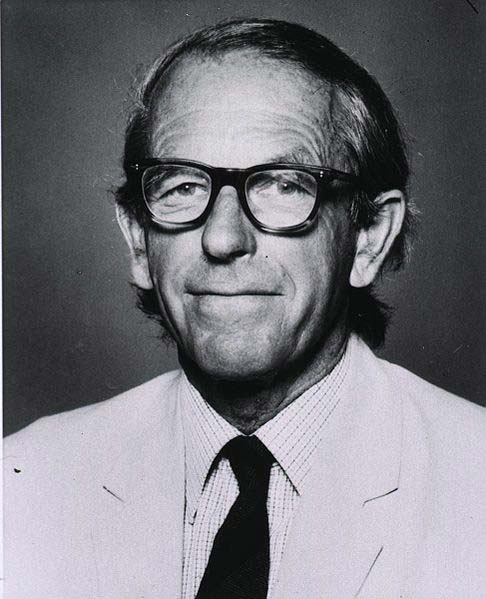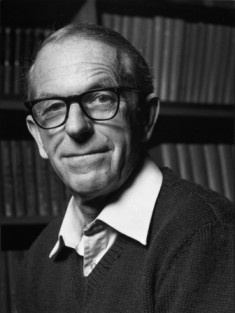| Frederick Sanger | |
|---|---|
 |
|
| Biochemist | |
| Specialty | DNA dideoxy sequencing, Insulin amino acid sequence |
| Born | Aug. 13, 1918 (age 95) Rendcomb, Gloucestershire, England, United Kingdom |
| Nationality | British |
Frederick Sanger is a famous British biochemist who received a Nobel Prize for Chemistry two times. In 1958, Frederick was given a Nobel Prize in Chemistry for his work on the structure of proteins and insulin. In 1980, Walter Gilbert and Frederick shared the Nobel Prize in Chemistry for the contributions in regards to the base sequence in nucleic acids. Sanger was the fourth person to be awarded two Nobel prizes.
Early Life
Frederick was born on August 13, 1918, in Rendcomb, England. He was the second son and one of the three children of Frederick Sanger. His brother was one year older while the sister Mary was five years younger. His dad worked as Anglican missionary in another country, but he later returned to his home country of England because of bad health. Soon after his two sons were born, Singer’s father decided to convert to Quakerism. As a result, Frederick and his siblings were brought up as Quakers.
When Frederick was five years old, his family moved to a small village in Warwickshire. The family was quite wealthy and even employed a governess to teach their kids. In 1927, when he was nine years old, Frederick was sent to Downs School. This was a residential preparatory school that was run by Quakers just near Malvern. At the age of 14, in 1932, he joined the Bryanston School located in Dorset. This school used the Dalton system and actually had a much more liberal regime than Frederick preferred.
Sanger’s College Years
In school, Sanger achieved great results. In 1936, he moved to St. John’s College in Cambridge to study the natural sciences. At first, he took courses in chemistry, physics, mathematics and biochemistry, but he had problems with mathematics and physics. In his second year, he decided to replace physics and physiology. It took him three years to get his Part I. He decided to study biochemistry for his Part II. During his first two years in college, both his mom and dad died from cancer; his dad was only 60 and his mother was 58.
As an undergraduate, Frederick Sanger was a pacifist and also a member of the Peace Pledge Union. While studying his Part II exams, he met Joan and they married after he graduated in December of 1940. After they got married, he started studying for his PhD under N.W. Pirie. He was given a project to research whether some edible protein could actually be obtained from the grass. After Pirie left this department, Frederick changed his project to concentrate of metabolism of lysine. He was awarded a doctorate in 1943.
Sequencing Insulin
 In 1943, Frederick Sanger joined the team of Charles Chibnall who was a protein chemist and a chair in Department of Biochemistry. Charles had already done a bit of research on amino acids and advised Frederick to look at the different amino groups in protein. During this time, insulin was bought from Boots (a popular UK pharmacy chain at the time) and it was amongst the very rare proteins that were available in pure form.
In 1943, Frederick Sanger joined the team of Charles Chibnall who was a protein chemist and a chair in Department of Biochemistry. Charles had already done a bit of research on amino acids and advised Frederick to look at the different amino groups in protein. During this time, insulin was bought from Boots (a popular UK pharmacy chain at the time) and it was amongst the very rare proteins that were available in pure form.
His first achievement was to determine a complete amino acid sequence of the two polypeptite chains of the bovine insulin, A & B. This took place in 1952 and 1951. Before this, many people believed that proteins were amorphous. While determining these sequences, he was able to prove that proteins have defined chemical composition.
Sanger’s Other Works
Through his experiments, he was actually able to come up with the sequence of many peptides by using several different experiments for initial partial hydrolysis. After this, the sequences were then assembled into longer sequences to create a complete structure of the insulin. In 1962, Sanger became the head of the Protein Chemistry division. After this, he started studying the sequencing of RNA molecules.
In 1958, he received the Nobel Prize in Chemistry for his groundbreaking research on the protein structure. In 1980, he was awarded this prize again for his work in determining the amino acid sequences of DNA information. His other contributions involved the basic genetic principle utilized by most biotechnology application. Throughout his life, he received many other honors for his amazing work on genetics and biotechnology.
Later Life
Frederick Sanger retired in 1983 in his home near Cambridge. He rejected the knighthood since he never wanted to be referred to as ‘Sir.’ In 1986, Frederick was awarded the award of O.M. (Order of Merit). He is currently married and has three children; son, Robin, born in 1943, Peter, born in 1946, and Sally, born in 1960.